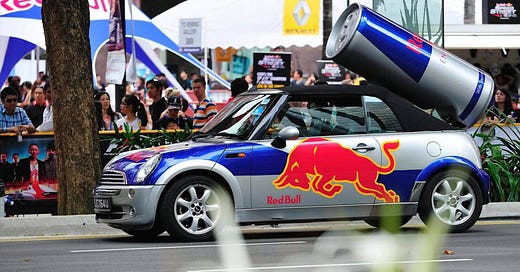Selling Stories Not Products - The RedBull Case Study...
Even though RedBull only sells energy drinks, how they market their brand will make you think otherwise. There are many marketing lessons we can learn from RedBull, here are a few...
Happy New Week,
To most people, Redbull is known for its energy drinks but they position themselves as much more than just an energy drinks company. Redbull owns several football clubs, runs two formula one teams, and is famous for its extreme sporting events and athletes. Redbull is a great example of a brand constantly thinking outside the box to connect with the consumers.
Redbull was founded in 1984 when the owner, Dietrich Mateschitz was suffering from jet lag in Thailand and decided to try a local drink that improved his jetlag drastically. Mateschitz decided to bring the product back home to Austria and pitched it to several investors but got turned down as they didn't see a market for energy drinks. Mateschitz still believed it was a huge opportunity so he partnered with the producer of the South Asian drink, and together invested a million dollars. They successfully launched the product in Austria and created a new product category: energy drinks.
“If we don’t create the market, it doesn’t exist.” Dietrich Mateschitz
Redbull outsources the production and logistics operations which frees them up to fully focus on selling their drinks. To sell their products Mateschitz first focused on the club scene and used student brand managers to promote Redbull on campuses. They had the Redbull Mini driving around campuses and they even got popular students to throw parties sponsored by Redbull. Now Vodka and Redbull is a frequent (unhealthy) combination ordered at clubs.
Redbull realised that in order to make more potential consumers aware and excited about their brand, they had to get their brand in front of people that will associate them with exciting and extreme sports and events. Instead of advertising its product, it advertises its brand and experiences. Redbull is famous for its unorthodox sporting events such as Redbull Air Race, Red Box Soap Box Racing, etc. Redbull is very inventive when it comes to creating high-octane events. They all fit their brand image of taking things to the edge. By focusing on telling attractive and gripping stories, based on adrenaline-fuelled, dangerous activities they’ve been able to build a successful brand.
Redbull has engrained themselves in the culture of extreme sports, they don’t just sponsor them but they create their own events and give these athletes a platform to showcase their talent to the world. Not only has Red Bull invested heavily in creating events, but they’ve played a major role in supporting extreme sports from grassroots levels, enabling extreme sports to become increasingly accessible.
My favourite thing about Redbull is its fully integrated entertainment and media value chain. Redbull engages with its customers in a deeper way than traditional advertising ever could because of the foundation they’ve created. They create their own stories through events and athletes they sponsor and create content with their own multi-platform media company, the Red Bull Media House. This means they own the rights to all content they use and can distribute them across all their channels like Social Media, Redbull TV, Redbull Bulletin, etc. With each event essentially acting as branded content, they’ve been able to create a content machine that constantly puts out engaging content their audience wants.
Redbull only has one product, their energy drink, and they make around 97% of their money through this product. All the projects they undertake are all to push the brand forward and ensure consumers keep associating Redbull with energy and being extreme.
Instead of telling stories about their product they tell stories about individuals living life to the extreme. Their athletes and teams all have unique stories. These stories are what their audience and the wider public resonate with. Many other brands can learn from Redbull, instead of just marketing your products, create and share stories of people that align with your brand. People buy into people, not products so create compelling stories and content that will naturally generate word of mouth.
Have a great week!



